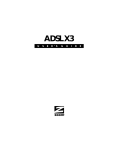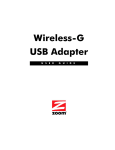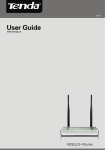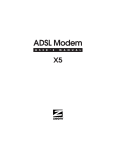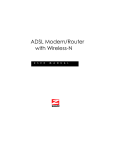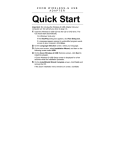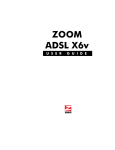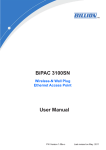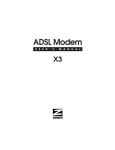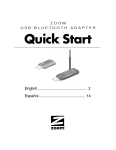Download Zenoah BKZ5000DL Brush Cutter User Manual
Transcript
ADSL X4 U S E R G U I D E NOTICE This document contains proprietary information protected by copyright, and this Manual and all the accompanying hardware, software, and documentation are copyrighted. No part of this document may be photocopied or reproduced by mechanical, electronic, or other means in any form. The manufacturer does not warrant that the hardware will work properly in all environments and applications, and makes no warranty or representation, either expressed or implied, with respect to the quality, performance, merchantability, or fitness for a particular purpose of the software or documentation. The manufacturer reserves the right to make changes to the hardware, software, and documentation without obligation to notify any person or organization of the revision or change. All brand and product names are the trademarks of their respective owners. © Copyright 2007 All rights reserved. Contents OVERVIEW ........................................................................................... 4 INSTALLATION INSTRUCTIONS ........................................................... 5 IMPORTANT! BEFORE YOU BEGIN................................................................... 5 INSTALLING THE X4 .......................................................................................... 7 WINDOWS INSTALLATION ............................................................................ 7 MACINTOSH AND LINUX INSTALLATION ................................................... 9 REMOVING THE X4 SOFTWARE...................................................................... 21 UNIVERSAL PLUG AND PLAY .......................................................................... 22 IF YOU NEED HELP ......................................................................................... 22 STATUS MONITORING ....................................................................... 23 MONITORING SYSTEM STATUS ....................................................................... 24 MONITORING ADSL STATUS ......................................................................... 25 ADVANCED SETUP OPTIONS ............................................................. 26 HOW TO USE THE ADVANCED OPTIONS ..................................................... 27 CONFIGURATION BUTTONS ............................................................................ 28 STATUS BUTTONS ............................................................................................. 31 ADMINISTRATION BUTTONS ........................................................................... 32 CHANGING YOUR WAN SETTINGS ............................................................... 33 CHANGING YOUR FIREWALL SETTINGS ....................................................... 34 CHANGING USER NAMES AND PASSWORDS ................................................. 35 BACKING UP YOUR CONFIGURATION .......................................................... 37 RESTORING DEFAULT SETTINGS ................................................................... 39 USING IP FILTERS ............................................................................................ 40 APPENDIX A. ADSL INTERNET SETTINGS TABLES ...........................41 APPENDIX B. FRONT AND BACK PANELS .......................................... 44 APPENDIX C. TCP/IP NETWORK SETTINGS .................................... 46 MACINTOSH TCP/IP SETTINGS ..................................................................... 47 LINUX TCP/IP SETTINGS ............................................................................... 49 WINDOWS TCP/IP SETTINGS ........................................................................ 50 APPENDIX D. TROUBLESHOOTING................................................... 53 APPENDIX E. REGULATORY INFORMATION ..................................... 58 Overview The X4 is an ADSL modem and a gateway/router all contained in one device. The ADSL modem gives you a connection to the Internet through your Internet service provider. The gateway/router provides an interface between the Internet and your own local network. It also includes an advanced firewall, which allows you to control Internet access from your local network, and which protects your local network from unwanted Internet traffic. The X4 modem is also enabled for Universal Plug and Play (UPnP™). This means that if you plug other devices with UPnP capabilities into your computer or network (for example, a gaming application, router, or stand-alone firewall) they will automatically detect the X4 and make the needed configurations for them to work together. This User Guide contains installation instructions for Macintosh and Linux computers, which can also be used for manually installing the X4 on a Windows computer. There is also information about the X4’s advanced setup options. Though most users will not need to use the advanced setup options, there are cases in which these advanced settings are necessary (for example, if you have a static IP address). 4 1 Installation Instructions This chapter covers the basic instructions needed to install your X4 and connect to the Internet. These instructions can be used with a Macintosh, Linux, or Windows operating system. Important! Before You Begin Before installing your X4, you must have ADSL service enabled on your telephone line. To do this, you need to sign up with an ADSL service provider. (Your service provider may refer to “ADSL service” as “DSL service.”) Package Contents Your package contains the items shown below: Zoom X4 ADSL Modem USB Cable Phone Cord Power Cube Ethernet Cable Software CD-ROM Chapter 1: Installation Instructions 5 The CD contains the installation software, documentation, warranty, and Customer Support information. If anything is missing or damaged, please contact Zoom Customer Support or your retailer or distributor. In addition, the package may include: • Phone-jack adapter to adapt the phone cord to a particular phone jack (certain countries only) • ADSL line filter(s) (certain units only) You Will Also Need • One of the following: ¾ A Windows Vista, XP, 2000, Me or 98 computer with an Ethernet or USB port. ¾ A Macintosh or Linux computer with an Ethernet port. ¾ A network device, such as a wireless access point, hub, router, or switch. • 6 An ADSL-enabled telephone wall jack to plug the X4 modem into. ADSL X4 User Guide Installing the X4 ¾ Macintosh and Linux users: please go to page 9. Windows Installation If you have already installed the X4 using the multilingual Installation Assistant on the CD, or if you are connecting the X4 directly to a hub or network device, skip this section and begin with Chapter 2, Status Monitoring, on page 23. Important: If you intend to use the X4’s USB option, you must remove any existing USB modem drivers on your Windows computer before installing this software. On the desktop, click the Start button, and then—depending on your operating system— either click Control Panel, or click Settings and then Control Panel. In Control Panel, double-click Add/Remove Programs (Vista users: select Programs and Features and then Uninstall or change a program). On the Install/Uninstall tab, select the USB modem you are removing, click Remove or Uninstall, and then click OK. If you encounter a problem using the Installation Assistant, follow the instructions for Macintosh and Linux users starting on page 9. 1 Turn your computer on. For Windows Vista only, follow these steps to turn on Telnet Client: a b c d e Click Start, select Control Panel, then double-click Programs and Features. In Programs and Features, in the Tasks pane, click Turn Windows features on or off. At the User Account Control message, click Allow. In the Windows Features dialog box, select Telnet Client, click OK, and wait while the feature is configured. In the Uninstall or Change a Program window, click the Close box to exit. Chapter 1: Installation Instructions 7 2 Close all open programs, including antivirus software or popup blockers. 3 Insert the supplied CD into the CD drive of your computer. The CD should start automatically. (If the CD does not start automatically, on the desktop, click the Start button, click Run, and then type E:\setup.exe, where E is the letter of your CD drive.) Windows Vista: If the AutoPlay dialog box appears, click Run Setup.exe: If the User Account Control dialog box appears, click Allow. 4 Select your language, select Installation Wizard, and follow the prompts to install the X4. 8 ADSL X4 User Guide Windows Vista: If a message tells you that Windows can't verify the publisher of the driver software, select Install this driver software anyway. If you are prompted to enter your user name and password, remember that they are case-sensitive: 5 When you complete the installation and setup, click Finish to update your modem and close the Install Assistant. Congratulations! You have established communication and your computer is now connected to the Internet. Macintosh and Linux Installation There is no software installation for Macintosh and Linux systems. Windows users: If you did not run the Install Assistant on the CD, follow these instructions to install the hardware and configure your X4. Installing the Hardware 1 Shut down and power off your computer. 2 Connect the modem to the computer’s Ethernet jack or to a network device (such as a hub). If you are using a Windows Chapter 1: Installation Instructions 9 computer, you also have the option of connecting to your computer’s USB port. However, we recommend that Windows users connect to an Ethernet jack if one is available. ¾ If you are using a computer’s Ethernet port: Plug one end of the Ethernet cable into the modem’s ETHERNET LAN port and plug the other end into your computer’s Ethernet port. ¾ If you are using a Windows computer’s USB port: Plug one end of the USB cable into the modem’s USB port and the other end into your computer’s USB port. ¾ If you are connecting the X4 directly to a hub, switch, wireless access point, or other network device: Plug one end of the Ethernet cable into the modem’s ETHERNET port and the other end into the network device’s Ethernet jack (which is typically called an Uplink or Expansion port). The modem’s ETHERNET LAN or USB connector is at the back of the modem. Tip: Windows users can connect two computers to the X4, one on the Ethernet jack and the other on the USB port, and share Internet access. 3 Plug the power cube into a power strip or wall outlet and then plug the power cube’s other end into the modem’s POWER jack. Important! Use only the power cube shipped with the X4. Other power cubes may damage your hardware. After you plug in the power cube, the POWER light on the front panel of the modem should become steady on, and the 10 ADSL X4 User Guide DSL light should blink once. If the POWER light does not turn on, make sure there is power at the wall outlet or power strip where you plugged in the power cube. 4 Turn the computer on. If you are using the USB port, you may see a Found New Hardware box indicating the progress of the installation. Typically no user action is necessary. If you are using Windows XP, you may be required to click Next. Depending on your operating system, you may also see a Hardware Installation box or a Digital Signature Not Found box. You can safely ignore these messages and click Yes or Continue Anyway. If prompted, click Finish and/or Yes to restart your computer at this point and then finish setting up your new hardware. 5 Plug one end of the supplied phone cord into the modem’s DSL port and the other into the ADSL wall jack. The DSL light should blink and then become steady on. If it does not, refer to the Troubleshooting section on page 53. Note: We recommend that at this point, if you haven’t already done so, you put an ADSL filter on every phone connected to the ADSL phone line. DO NOT put a filter between the X4 and the wall jack that it is connected to. (In some countries, including the UK, a splitter is supplied with the X4. The PHONE line plug of the splitter plugs into the wall jack that has ADSL service, and the X4 plugs into the splitter's MODEM jack, which is not filtered. The PHONE jack, for an optional telephone, is filtered.) Congratulations! You have installed the hardware. Now continue below with Establishing Communication. Chapter 1: Installation Instructions 11 Important! You must ensure that your computer’s TCP/IP settings are configured properly. See Macintosh TCP/IP Settings on page 47 or Linux TCP/IP Settings on page 49 for instructions on how to do this. Establishing Communication You must set up the X4 so that it can communicate with your Internet service provider. To do this, you use the Zoom Configuration Manager. 1 Follow these two steps to log in to the Zoom Configuration Manager: a Open your Web browser and, in its address bar, type http://10.0.0.2 if you are using the Ethernet jack or http://10.0.0.3 if you are using the USB port (Windows only), then press the Enter key on your keyboard. b When prompted, type the following user name and password in the appropriate boxes, then click OK. You must enter them using lowercase letters. User Name: admin Password: zoomadsl If you are not prompted for a user name and password, do the following in this order: Recheck all connections; restart the modem and computer; and reset the modem by inserting a paper clip into the Reset pinhole in the center of the modem’s back panel and holding it for five seconds. The user name and password you enter here do not serve the same purpose as any name and password that your Internet service provider may have given you. 12 ADSL X4 User Guide 2 The Zoom Configuration Manager opens and displays its Basic Setup page. Use this Web page to configure the modem so it can connect with your Internet service provider. You can configure the X4 manually or you can have the modem automatically configure itself. Depending on your situation, do the following: ¾ Select MANUALLY if one or both of the following are true: You already have the VPI, VCI, and Encapsulation settings from your Internet service provider. You have a static IP address that you plan use with the X4. (Only those whose Internet service provider instructs them to use a static IP address and advanced users with special configuration needs will require static IP addressing.) To continue configuring the modem manually, skip the rest of the steps in this section and follow the instructions on page 16 (if you are NOT using a static IP address) or on page 19 (if you have a static IP address). Chapter 1: Installation Instructions 13 ¾ Select AUTOMATICALLY if neither of the special circumstances mentioned above fits your situation. When this option is selected, the screen changes to show automatic configuration options. Do the following: a Select the Enable option button, then click Save Changes. b The page changes to the Autodetect page and a Start button appears. Click the Start button to begin the automatic configuration. A message appears to let you know that the current configuration, if any, will be lost when the X4 configures itself. Click OK to dismiss this message. c Wait while the X4 modem searches for the correct VPI, VCI, and Encapsulation settings and connects with your Internet service provider. This may take a few minutes because the modem must try various combinations until it finds the settings that match your service provider’s. 3 Once the modem detects your settings, your VPI, VCI, and Encapsulation settings will appear in the table on the Autodetect page. Click the Encapsulation setting to continue with the process. When your Encapsulation setting appears, click it to continue with the process. (Note that yours may be something other than PPPoE.) Note: If your Encapsulation setting is not found (that is, if “No Encapsulation Protocol Detected” remains on the screen), select the Disable option button, click Save Changes, then click the Basic Setup icon at the top of the screen and try to manually configure the modem, as explained in Configuring the X4 Manually on page 16. 14 ADSL X4 User Guide 4 Depending on your Encapsulation setting, the following will happen when you click it: ¾ If your Encapsulation setting begins with PPP: You will be prompted for your Login Name and Password. Your Internet service provider should have given you a User ID or Username (usually your email address or the characters preceding the @ sign in your email address) and a Password. Enter this information in the applicable boxes, then click Save Changes. A screen appears to let you know that the process was a success. Click Close to return to the Autodetect page and notice that the Encapsulation setting has changed from bold to regular text. (These are NOT the same User Name and Password you that you used earlier to open the Zoom Configuration Manager.) When the configuration is complete, your Encapsulation setting will change from bold to regular text. Tip: If you do not know your Login Name and Password, contact your service provider and tell them that you misplaced the information. ¾ If your Encapsulation setting begins with something other than PPP: The EOA Interface—Add page will open. Click Save Changes on this page (without changing any settings on it). A screen appears to let you know that the process was a success. Click Close to return to the Autodetect page and notice that the Encapsulation setting has changed from bold to regular text. 5 On the Autodetect page, click Write Settings to Flash. Chapter 1: Installation Instructions 15 6 Verify that your Internet connection is working. Open your Web browser and try to connect to a familiar Web address. If you connect successfully, your installation is complete and you are ready to browse the Web! Congratulations! You have completed all you need to do to get your computer on the Internet. The remainder of this user’s guide is for troubleshooting and for advanced users who need information about status monitoring and advanced setup options. Important! If you did not connect, see Appendix D: Troubleshooting on page 53. Configuring the X4 Manually Some users may need to configure the X4’s IP settings manually, instead of having the modem automatically configure itself. Typically, you would manually configure your modem if: • You already have the VPI, VCI, and Encapsulation settings from your Internet service provider. • You have a static IP address that you plan to use with the X4. If this is the case, skip this section and continue with Using Static IP Addressing on page 19. • The auto configuration process was unable to find your settings. Manually configuring the modem requires that you log in to the Zoom Configuration Manager and enter information on its Basic Setup page. (If you need help logging in, see page 12.) 1 On the Basic Setup page, ensure that the MANUAL option button is selected. 2 Do the following, depending on whether you know your VPI, VCI, and Encapsulation settings: 16 ADSL X4 User Guide ¾ If your Internet service provider gave you the settings, continue with step 3 below. ¾ If you do not know the settings, refer to the ADSL Internet Settings Tables beginning on 41. Find your service provider on the list and make note of its settings. If there is more than one listing for your service provider, the most common one is labeled (1), the next (2), and so on. Tip: If you are in the United States and your service provider is not on the list, use the settings for Service Provider Not Shown at the bottom of the table. 3 Select Enabled from the Current Connection drop-down list. (That is, click the arrowhead at the far right of the box to view the items in the list, then select Enabled.) 4 Select your service provider’s Encapsulation setting from the Encapsulation drop-down list. Depending on your selection, do the following: ¾ If your Encapsulation setting begins with PPP: Enter your Username and Password in the boxes provided. Your Internet service provider should have given you a User ID or User Name (usually your email address or the characters preceding the @ sign in your email address) and a Password. (These are NOT the same User Name and Password you that you used earlier to open the Zoom Configuration Manager.) Tip: If you do not know your Username and Password, contact your service provider and tell them that you misplaced the information. ¾ If your Encapsulation setting begins with 1483 Bridged or 1483 Routed: The Username and Password boxes will automatically disappear from the page because you do not need to enter this information. Continue with step 5. Chapter 1: Installation Instructions 17 Important! If you plan to use a static IP address, you must manually configure the X4 from the WAN Configuration page and not the Basic Setup page. For more information, see Using Static IP Addressing on page 19. Typically, you must make arrangements with (and pay) your Internet service provider for a static IP address. 5 In the VPI and VCI boxes, enter the settings for your service provider. 6 Click Save Changes and then Write Settings to Flash. Once the process is complete, the X4’s DSL light should remain on steady (this should take about 15 seconds). 7 Verify that your Internet connection is working. Open your Web browser and try to connect to a familiar Web address. If you connect successfully, your installation is complete and you are ready to browse the Web! Congratulations! You have completed all you need to do to get your computer on the Internet. The remainder of this user’s guide is for troubleshooting and for advanced users who need information about status monitoring and advanced setup options. If You Did Not Connect If you did not connect and you are using settings provided by your service provider, repeat steps 3–7 above and ensure that you enter the information correctly (especially your Username and Password, if your Encapsulation begins with PPP). If you still cannot connect, look up your provider in the ADSL Internet Settings Tables on page 41 and try the setting(s) shown, if different. If you did not connect and were using settings from the ADSL Internet Settings Tables, return to the tables and find the next most frequently used settings—those labeled (2) if you just entered (1), or (3) if you just entered (2), and repeat steps 3–7 above. 18 ADSL X4 User Guide Using Static IP Addressing If your Internet service provider’s Encapsulation setting is either 1483 Bridged or 1483 Routed, the X4 can be set for either a Dynamic Host Configuration Protocol (DHCP) address (also known as a dynamic IP address) or for a static IP address. Because most Internet service providers use DHCP, the X4 is set for dynamic IP addressing by default. There is typically an extra charge for a static IP address, and you usually have to make a special request to get one. Important! If you do not know what static IP addressing is or why you would use it, you most likely do not need to change the default setting. Only advanced users who specifically want to use static IP addressing and/or those users whose IP provider specifically instructed them to use static IP addressing should change this setting. 1 Click the Advanced Setup icon at the top of any page in the Zoom Configuration Manager to open the Advanced Setup page. 2 Click the WAN Configuration button, located in the Configuration group. Chapter 1: Installation Instructions 19 3 Enter the appropriate information on the WAN Configuration page. Use the table below as a guide. For this setting… Do this… Current Connection Select Enabled from the drop-down list. at the (That is, click the arrowhead far right of the box to view the items in the list, then select Enabled.) Encapsulation Select your service provider’s Encapsulation setting from the drop-down list. VPI and VCI Enter the VPI and VCI settings for your service provider. (If you do not know these settings, refer to the ADSL Internet Settings Tables on page 41.) Bridge and IGMP Ensure that Disabled is selected from both drop-down lists. IP Address and Subnet Mask Enter the values assigned to you by your service provider for each. Use DHCP Ensure that the Disabled option button is selected. Default Route Ensure that Enabled is selected from the drop-down list. Gateway IP Address Enter the value assigned to you by your service provider. Use DNS Ensure that the Disabled option button is selected. Primary DNS Server Enter the value assigned to you by your service provider. Secondary DNS Server If your service provider gave you a second DNS server address, enter it. 4 Click Save Changes on the WAN Configuration page. 5 You are redirected automatically to the Basic Setup page. Click Write Settings to Flash. 20 ADSL X4 User Guide 6 Verify that your Internet connection is working. Open your Web browser and try to connect to a familiar Web address. If you connect successfully, your installation is complete and you are ready to browse the Web! Congratulations! You have completed all you need to do to get your computer on the Internet. The remainder of this user’s guide is for troubleshooting and for advanced users who need information about status monitoring and advanced setup options. Important! If you did not connect, see Appendix D: Troubleshooting on page 53. Removing the X4 Software If you have a Windows computer and want to remove your X4— for instance, if you move your computer to a location without ADSL service—you should remove the software before disconnecting the hardware. Note: Because Macintosh and Linux computers do not require the X4 software be installed, users of those operating systems do not have to remove the software prior to removing the X4. 1 From your Windows desktop, click the Start button, point to Programs, then point to Zoom ADSL Modem, then select Uninstall X4 ADSL Modem. 2 When prompted to confirm your choice, click Yes. 3 When the process is complete, you will be prompted to click Finish. 4 Unplug your X4 hardware. Chapter 1: Installation Instructions 21 Universal Plug and Play The X4 is enabled for Universal Plug and Play (UPnP™). This means that other devices plugged into your computer or network (for example, a gaming application, router, or stand-alone firewall) that use UPnP will automatically detect the X4 and make the needed configurations for them to work together. There is no setup for you to do. If You Need Help Zoom has many Technical Support services available to its customers. You can access these services in a variety of ways: • Visit our Web site at www.zoom.com and select Technical Support. From there, you can register your X4 and/or contact our technical support experts and/or use our intelligent database SmartFactstm and/or get warranty information. Tip: From time to time, Zoom may release improved firmware. This is also available at www.zoom.com, along with upgrade instructions. We recommend that you check our Web site periodically for updates. • Call our support office. The appropriate number depends on your country: US: (561) 241-7170 UK: 0870 720 0090 Other country (US number): (561) 997-9683 • 22 Some retailers of Zoom products provide support or can recommend a convenient support center. ADSL X4 User Guide 2 Status Monitoring This chapter discusses how to check the status of your modem and its ADSL connection. Most users can skip this chapter, as it is primarily for advanced users and for those who are instructed by their Internet service provider or Zoom Technical Support to verify settings, usually for troubleshooting. If you are using an access point or a network hub, you can monitor your X4 from any of the computers that are connected to the access point or hub. Why Monitor Status? The X4 provides two easy-to-read screens for you to review the status of the modem and its ADSL connection. While most users will probably never need to check the status, there are some cases in which it would be helpful. For example, you may need to know the IP address assigned to you by your Internet service provider. For advanced users with special configuration needs, the status information is useful for overall system maintenance. Chapter 2. Monitoring Status 23 Monitoring System Status If you want to check the overall system status, click the System Status icon at the top of any page in the Zoom Configuration Manager. (If you forgot how to log in to the Zoom Configuration Manager, see page 12.) The System Status page provides information about many aspects of your X4, including how long it has been since you last rebooted the modem, your WAN settings, your LAN settings, and so forth. For more detailed information about the system status information provided, click the Help icon at the top of the System Status page to open the online help. 24 ADSL X4 User Guide Monitoring ADSL Status If you want to check the status of your ADSL connection, click the ADSL Status icon at the top of the Zoom Configuration Manager. (If you forgot how to log in to the Zoom Configuration Manager, see page 12.) The ADSL Status page provides information about your ADSL connection. For example, you can verify whether your ADSL connection is active or not (the ADSL Status setting will display Showtime if connected). You can also monitor related ADSL parameters—for example, how fast the X4 is transferring data (Downstream Speed and Upstream Speed). Note: The ADSL Status page does not provide a way to change any of these settings—see Chapter 3, “Advanced Setup Options,” on page 27 if you need to make changes to these settings. For more detailed information about the ADSL status information provided, click the Help icon at the top of the ADSL Status page to open the online help. Chapter 2. Monitoring Status 25 3 Advanced Setup Options The options that are set by default when the X4 is installed are sufficient for most users. However, those that want or need to change the X4’s settings can do so using the Advanced Setup page. This chapter explains how to specify advanced options. The information in this chapter applies to you if: • Your Internet service provider instructs you to enable, disable, or change the default settings for your X4 in order for it to work properly with your ADSL service. See How To Use the Advanced Options on page 27 for a table listing the Advanced Setup areas that you can customize. • You need to change your Wide Area Network settings (for example, if you have a static IP address). See Changing Your WAN Settings on page 33 for more information. • You want to change the default firewall settings (for example, if you have multiple computers connected to the Web, you can specify that one or more users receive an email alert if the network is attacked). See Changing Your Firewall Settings on page 34 for more information. • You want to change your ADSL password. See Changing User Names and Passwords on page 35 for more information. • You have customized your configuration and want to back it up for future use. See Backing Up Your Configuration on page 37 for more information. • You want to add, remove, or change the IP Filters. See Using IP Filters on page 40 for more information. 26 How To Use the Advanced Options Configuring the X4 for the situations described at the beginning of this chapter requires the use of the Advanced Setup page. To access this page, click the Advanced Setup icon at the top of any page in the Zoom Configuration Manager. (If you forgot how to log in to the Zoom Configuration Manager, see page 12.) You will notice that there are numerous buttons on the page, broken into three groups: Configuration, Status, and Administration. Most users will not need to use any of the buttons on the Advanced Setup page. 27 Tip: If you plan to specify advanced options, you can view detailed information about each option in the online help. To open the help, click the button for the settings you want to specify (for example, the Firewall button to open the Firewall Configuration page), then click the Help icon at the top of the screen to open a help topic specifically about the page you are viewing. Configuration Buttons Use the buttons in the Configuration group to perform advanced configuration tasks. This button… Opens a page that lets you… WAN Configuration Specify how your Wide Area Network ADSL setup is configured. This page is also where you would set up a static IP address (if you have arranged for one with your Internet service provider). Port Settings Set the ports used when you use FTP or Telnet with the device or if you are running a Web server behind it. Bridging Specify which device interfaces are capable of bridging data between your LAN/WAN and Internet service provider. Interfaces can be routable (for example, assigned an IP address), bridgeable, or both. Dynamic DNS Enter the Host name you registered with a Dynamic DNS service provider. This page is for those who are using dynamic IP addressing (the X4’s default) and want to host a Web site. The Dynamic DNS service provider keeps track of your constantly changing IP address and routes those trying to access your Web site to the correct location. SNMP Set up Simple Network Management Protocol (SNMP). This enables a host computer to access configuration, performance, and other system data that resides in a database on the modem. Management Control Enable or deny access to X6 services – HTTP, Telnet, UPnP, SNMP, TFTP – to local network devices and/or remote users. 28 ADSL X4 User Guide This button… Opens a page that lets you… IP Filtering Set up rules to control the forwarding of incoming and outgoing data between your LAN and the Internet and within your LAN. For example, you can create IP filter rules to block attempts by certain computers on your LAN to access certain types of data or Internet locations. You can also block or allow incoming access to computers on your LAN. This page displays the current filters and lets you edit and add filters. DHCP Specify Dynamic Host Configuration Protocol (DHCP) settings to enable network administrators to centrally manage the assignment and distribution of IP information to computers on a network. When you enable DHCP on a network, you allow a device (such as your X4’s router or a router located with your Internet service provider) to assign temporary IP addresses to your computers whenever they connect to your network. IP Routing Set up the routes on which you want the X4 to send data it receives on a particular interface (for example, LAN interface, Ethernet interface, etc.) Routes specify the IP address of the next device interface or Internet destination to forward data to, given the ultimate destination of the data. Blocked Protocols Select the protocols you want blocked from your computer (for example, IP Milticast, NetBEUI, IPX, APR, AppleTalk). Bridge Filter Filter packets at the Ethernet protocol level. Parental Controls Block Internet access from one or more computers on the network for a specified time period each day. Firewall Modify the default firewall settings. For example, use this page to specify the email address(es) to which you want an alert sent if your computer/network is attacked. NAT Specify Network Address Translation settings. The most common reason for changing the default settings is if you have a LAN and require each computer to have its own public IP address. Otherwise, the default NAT setting provides sufficient protection for most users. 29 This button… Opens a page that lets you… RIP Specify whether the X4 can communicate with other routing devices and, if so, on which interfaces. It also lets you specify how long routes remain in memory. LAN Specify the settings that control the connection between the X4 modem and your Ethernet jack or USB port (depending on which you used to connect the modem). UPnP (Universal Plug and Play) Connect automatically with other UPnP-enabled software and hardware. The Internet Gateway Device (IGD) protocol makes it possible for applications running on the network to automatically configure NAT routing. 30 ADSL X4 User Guide Status Buttons The buttons in the Status group are typically used for maintenance and troubleshooting. The following table lists each button in the Status group and gives a brief description of the settings you can specify. Click a button below, then click the Help icon at the top of the screen to open an online help topic about the page you are viewing. This button… Opens a page that lets you… ADSL Status View in-depth information about your ADSL connection. PPP Status Configure a Point-to-Point Protocol (PPP) to enable communication between the X4 modem and your Internet service provider. TCP/IP Status View information about the IP packets handled by your modem. EoA Status Configure an Ethernet-over-ATM (EoA) interface on the ADSL/Ethernet router, if one is needed to communicate with your ISP. ATM Status Configure an Asynchronous Transfer Mode (ATM) Virtual Circuit (VC) interface to enable the X4 to communicate using the ATM protocol. IPoA Status Configure an Internet Protocol over ATM (IPoA) interface on the ADSL/Ethernet router. An IPoA interface can be used to exchange IP packets over the ATM network, without using an underlying Ethernet over ATM (EOA) connection. 31 Administration Buttons The buttons in the Administration group are typically used for administrative tasks, such as diagnostic testing, upgrading firmware, changing your Zoom Configuration Manager password, etc. Click a button below, then click the Help icon at the top of the screen to open an online help topic about the page you are viewing. This button… Opens a page that lets you… User Configuration Manage the User IDs and passwords that can access the Zoom Configuration Manager. This is where you can change the default password supplied to you with the X4. Firmware Update Specify the path to the upgrade file you need to update your firmware. Use the Browse button on this page to navigate to the file, then click the Upload button to perform the firmware update. Set Date and Time Set the X4’s internal date and time settings (including time zone and whether Daylight Savings Time is in effect). Diagnostics Run a series of diagnostic tests of your system software and hardware connections. You can also run the Ping and Traceroute utilities to troubleshoot connection problems. Backup/Restore Config Save your current configuration settings so that they may be restored at a later time. SNTP Synchronize the X4 with an SNTP (Simple Network Time Protocol) server. System Log View data generated or acquired by routine system communication with other devices. This information does not necessarily represent unexpected or improper functioning and is not captured by the system traps that create alarms. You can save the system log to a file. Reboot Reboot the X4 and reset its configuration to the factory defaults. 32 ADSL X4 User Guide Changing Your WAN Settings Use the WAN Configuration page to change your Wide Area Network (WAN) settings and to specify a static IP address (if you have arranged/paid for one). To open this page, click the WAN Configuration button on the Advanced Setup page. Important! If you want to use static IP addressing, see Using Static IP Addressing on page 19 for information on how to do this. The settings you can change on this page include Encapsulation, VPI, VCI, DHCP Client, IP Address, Subnet Mask, and so forth. Once you have made the changes you want on this page, click the Save Changes button, and then click the Write Settings to Flash button. For more information about changing your WAN Configuration settings, click the Help icon at the top of the screen while you are on this page. This opens the online help and displays a topic containing detailed information about the WAN Configuration page. 33 Changing Your Firewall Settings Use the Firewall Configuration page to change the X4’s firewall settings. To open this page, click the Firewall button in the Configuration section of the Advanced Setup page. When you install the X4, a firewall is automatically established to offer your computer protection as you use the Internet. (This built-in firewall is in addition to the NAT settings on your X4.) By default, the firewall is set up to be relatively strict – that is, the only Internet traffic it allows to access your computer is that which you are likely to need (for example, a Web page you request in your browser’s address bar). For most users, this access is secure and sufficient. Most users will never need to change their firewall settings. However, use the Firewall Configuration page if you want to: • Blacklist computers that try to hack into your computer or network so that they are denied access. (By default, this feature is disabled.) • Have email sent if your computer or network is attacked by an outside computer. Once you have made the changes you want on this page, click the Save Changes button, and then click the Write Settings to Flash button. For details about the individual firewall settings you can specify, click the Help icon at the top of the screen while you are on the Firewall Configuration page. This opens the online help and displays a topic containing detailed information about the X4’s firewall settings. 34 ADSL X4 User Guide Changing User Names and Passwords Use the User Configuration page to manage the user names and passwords that can access the Zoom Configuration Manager. To open this page, click the User Configuration button, located in the Administration group on the Advanced Setup page. When you installed the X4 and tried to open the Zoom Configuration Manager, you were prompted for a User Name and Password in order to gain access. (The default name and password were supplied to you on page 12.) If you want, you can change the default password. Changing the password is not required. To change the default password 1 On the User Configuration page, locate the row that contains the default admin user name. (Unless you have added additional users, it should be the only row shown.) 2 Click the pencil icon at the right end of the row to open the User Config – Modify screen. 3 In the Old Password box, enter zoomadsl. (This is the default password you used on page 12 during installation.) Note that it must be typed in lowercase letters. 4 In the New Password box, enter the new password you would like to use. The password is case sensitive and cannot exceed 128 characters. 35 5 In the Confirm Password box, enter the new password again to confirm it. 6 Click Save Changes. A message appears to let you know that the password has been changed. Click Close to return to the User Configuration page. 7 Click Write Settings to Flash. In addition, you can also create additional logins (that is, user names and passwords) with varying degrees of access to the Zoom Configuration Manager. For more information about managing logins, click the Help icon at the top of the screen while you are on the User Configuration page. This opens the online help and displays a topic containing detailed information about user names and passwords. 36 ADSL X4 User Guide Backing Up Your Configuration Use the Backup/Restore Config page to back up your current configuration or restore an old configuration to your X4. To open this page, click the Backup/Restore Config button, located in the Administration group on the Advanced Setup page. Users who change the configuration settings for the X4 may want to back up their settings. This will enable them to restore those settings at a later time, if needed. This feature may be especially useful when you receive firmware updates from Zoom. Installing the update may overwrite your customized settings with default values. Before you update the firmware, backup your configuration. Then, after the firmware has been updated, restore your configuration. Note: You do not need to back up the default settings. This is because you can easily restore the defaults by clicking the Reboot button on the Advanced Setup page. For more information, see Restoring Default Settings on page 39. To back up your current configuration 1 On the Backup/Restore Config page, click Save Config to download a configuration file from the X4 to a folder on your computer. 2 Name the file and specify a location for it on your computer. Be sure to note the name and location. You will need this information if you ever want to restore the X4 to this backed-up configuration. 37 To restore a configuration 1 On the Backup/Restore Config page, click Browse and navigate to the file containing the configuration to which you want the X4 restored. 2 Click Upload. For more information about backing up and restoring your customized settings, click the Help icon at the top of the screen while you are on the Backup/Restore Config page. This opens the online help and displays a topic containing detailed information about this process. 38 ADSL X4 User Guide Restoring Default Settings If you have changed the system settings on your X4 and for some reason want to restore them to the factory default settings, you can do so in one of two ways: You can perform a software reset or a hard reset. To reset using the X4’s Web interface If you can open your Web browser and access your X4’s user interface, do the following to perform a software reset: 1 Log into the Zoom Configuration Manager and click the Advanced Setup icon to open the Advanced Setup page. (See page 12 if you need help logging in.) 2 In the Administration section, click the Reboot button. 3 From the Reboot Mode drop-down list, select Reboot From Default Configuration. 4 Click the Reboot button. Once this process is complete, your unit is reset to its factory settings. To perform a hard reset If you lose your link to the unit and cannot communicate with it via the Web browser, do the following to perform a hard reset: 1 Insert a paper clip into the RESET pinhole in the center of the modem’s back panel. 2 Hold it there for five seconds. The unit’s DSL light will turn off and then it will blink slowly, about once per second. You are now guaranteed that all system settings are restored to the X4’s factory defaults. 39 Using IP Filters Use the IP Filter Configuration page to set up IP filters to allow or block traffic coming into your computer from the Internet. To open this page, click the IP Filtering button in the Configuration section of the Advanced Setup page. To filter Internet traffic, you must define one or more rules (that is, criteria you want the information to meet before it can proceed). As information comes in from the Internet, the X4 examines it and—if it meets the rule—moves forward to its destination on your computer or network. If it does not, it is discarded. The rule can be based on many characteristics, including the network or Internet protocol it carries, IP address of the sending computer, the port that the traffic is coming in on, and so forth. Once you have set up the IP filters you want, click the Save Changes button, and then click the Write Settings to Flash button. For more information about setting up IP filters, click the Help icon at the top of the screen while you are on the IP Filter Configuration page. This opens the online help and displays a topic containing detailed information about this process. 40 ADSL X4 User Guide Appendix A ADSL Internet Settings Tables These tables are for customers whose service providers do not supply them with the ADSL settings to connect to the Internet. Many ADSL providers use different settings depending on the region in which they are operating, which is why there may be more than one setting for your service provider. We post updated tables on our Web site. If your country is not listed in the tables below, please consult www.zoom.com Note to USA customers If your ADSL service provider is not shown below, first use the settings for Service Provider Not Shown at the bottom of the table. If those settings do not work, use the settings for the company that provides local telephone service in your area. (Refer to page 16 for more detailed installation instructions on entering the settings.) Table A: USA Service Provider VPI VCI Encapsulation AllTel (1) AllTel (2) AT&T (1) AT&T (2) AT&T (3) August.net (1) August.net (2) BellSouth CenturyTel (1) CenturyTel (2) Covad Earthlink (1) Earthlink (2) Embarq (Sprint) (1) Embarq (Sprint) (2) GWI Hotwire Internet Junction Qwest (1) Qwest (2) SBC (1) SBC (2) 0 0 0 0 8 0 8 8 8 8 0 0 8 0 8 0 0 0 0 0 0 0 35 35 35 35 35 35 35 35 35 35 35 35 35 35 35 35 35 35 32 32 35 35 Appendix A. ADSL Internet Settings PPPoE LLC 1483 Bridged IP LLC PPPoE LLC 1483 Bridged IP LLC 1483 Bridged IP LLC 1483 Bridged IP LLC 1483 Bridged IP LLC PPPoE LLC PPPoE LLC 1483 Bridged IP LLC PPPoE LLC PPPoE LLC PPPoE LLC PPPoA LLC PPPoE LLC 1483 Bridged IP LLC 1483 Bridged IP LLC 1483 Bridged IP LLC PPPoA LLC PPPoA VC-MUX PPPoE LLC 1483 Bridged IP LLC 41 Service Provider VPI VCI Encapsulation SBC (3) Socket (1) Socket (2) Socket (3) Sonic Sprint (Embarq) (1) Sprint (Embarq) (2) Uniserve Verizon (1) Verizon (2) Service Provider Not Shown 8 8 0 0 0 0 8 0 0 0 0 35 35 35 35 35 35 35 33 35 35 35 1483 Bridged IP LLC 1483 Bridged IP LLC 1483 Bridged IP LLC PPPoE LLC 1483 Bridged IP LLC PPPoA LLC PPPoE LLC 1483 Bridged IP LLC PPPoE LLC 1483 Bridged IP LLC PPPoE LLC Table B: Countries Other Than The USA Service Provider VPI VCI Encapsulation Australia-Telstra Argentina-Telecom Argentina-Telefonica Belgium-ADSL Office Belgium-Turboline Bermuda (1) Bermuda (2) Bolivia (1) Bolivia (2) Brazil- 3 Corp (1) Brazil- 3 Corp (2) Brazil-Brasil Telcom Brazil-Telefonica Brazil-Telmar Brazil-South Region Colombia-EMCALI Costa Rica Denmark-Cybercity, Tiscali France (1) France (2) France (3) France (4) France (5) Germany Hungary Hungary-Sci-Network Iceland-Islandssimi Iceland-Siminn Israel Italy Jamaica (1) Jamaica (2) 8 0 8 8 8 0 0 0 0 8 8 0 8 0 1 0 1 0 8 8 8 0 8 1 1 0 0 8 8 8 8 0 42 35 33 35 35 35 35 35 34 35 35 35 35 35 33 32 33 50 35 35 67 35 35 35 32 32 35 35 48 48 35 35 35 PPPoA LLC PPPoE LLC PPPoE LLC 1483 Routed IP LLC PPPoA LLC PPPoA LLC PPPoE LLC 1483 Routed IP LLC PPPoE LLC PPPoE LLC Classical IP over ATM PPPoE LLC PPPoE LLC PPPoE LLC PPPoE LLC PPPoA VC-MUX PPPoA LLC PPPoA VC-MUX PPPoE LLC PPPoA LLC PPPoA VC-MUX 1483 Bridged LLC 1483 Bridged LLC PPPoE LLC PPPoE LLC PPPoE LLC PPPoA VC-MUX PPPoA VC-MUX PPPoA VC-MUX PPPoA VC-MUX PPPoA VC-MUX PPPoA VC-MUX ADSL X4 User Guide Service Provider VPI VCI Encapsulation Jamaica (3) Jamaica (4) Kazakhstan Mexico Netherlands-BBNED Netherlands-MX Stream Portugal Saudi Arabia (1) Saudi Arabia (2) Saudi Arabia (3) Saudi Arabia (4) Saudi Arabia (5) Saudi Arabia (6) Spain- Albura, Tiscali Spain- Colt Telecom, Ola Internet Spain -EresMas, Retevision Spain-Knet Comunicaciones S.L. Spain- Servidores Voz Spain-Telefonica (1) Spain-Telefonica (2), Terra Spain- Wanadoo (1) Spain- Wanadoo (2) Spain- Wanadoo (3) Sweden-Telenordia Sweden-Telia Switzerland Turkey (1) Turkey (2) UK (1) UK (2) Venezuela-CANTV Vietnam 8 0 0 8 0 8 0 0 0 0 0 0 0 1 0 8 8 0 8 8 8 8 8 8 8 8 8 8 0 0 0 0 35 35 33 35 35 48 35 33 35 33 33 35 35 32 35 35 32 33 32 32 35 32 32 35 35 35 35 35 38 38 33 35 Appendix A. ADSL Internet Settings 1483 Bridged IP LLC SNAP 1483 Bridged IP LLC SNAP PPPoA VC-MUX PPPoE LLC PPPoA VC-MUX PPPoA VC-MUX PPPoE LLC PPPoE LLC PPPoE LLC 1483 Bridged IP LLC 1483 Routed IP LLC 1483 Bridged IP LLC 1483 Routed IP LLC PPPoA VC-MUX PPPoA VC-MUX PPPoA VC-MUX PPPoA VC-MUX PPPoA VC-MUX PPPoE LLC 1483 Routed IP LLC PPPoA VC-MUX PPPoE LLC 1483 Routed IP LLC PPPoE 1483 Bridged IP LLC PPPoE LLC PPPoE LLC PPPoA VC-MUX PPPoA VC-MUX PPPoE LLC 1483 Routed IP LLC PPPoE LLC 43 Appendix B Front and Back Panels The front panel of the X4 looks like this: The following table describes the LEDs on the front panel. LED Description POWER Lights when the X4 is plugged into a power source. DSL Blinks when the X4 is trying to connect to your ADSL service. Steady on when the unit is connected to your ADSL service. Note: If the light fails to switch from blinking to steady after a minute or two, check with your ADSL provider that the ADSL connection is activated, or refer to Appendix D: Troubleshooting on page 53. PPP Steady green when a PPPoE or PPPoA Internet connection is established. Off when the X4 is in 1483 Bridged or Routed mode, or if there is no DSL connection. LAN Lights when the ETHERNET LAN port of the X4 is connected to the Ethernet port of a powered-up device. Blinks when data is sent. USB Lights when the USB port of the X4 is connected to the USB port of a powered-up device. Blinks when data is sent. 44 The back panel of the X4 looks like this: Port or button Description DSL Connects the modem to the ADSL telephone wall jack. USB Connects the modem to the USB port of a Windows computer. RESET Resets the modem to its factory settings. To reset, insert a paper clip and press the button three times. ETHERNET LAN Connects the modem to an access point, a network hub, or the Ethernet port of a computer. POWER Connects the modem to the power adapter. Appendix B. Front and Back Panels 45 Appendix C TCP/IP Network Settings If you are using a Macintosh or Linux computer, you must ensure that your computer’s TCP/IP network settings are configured properly. Otherwise, you will not be able to connect to the Internet. Note: If you are using a Windows computer, you do not have to configure the TCP/IP settings. This is because your Windows computer will automatically configure them for you. Only Windows users who are troubleshooting the X4 will need to verify the TCP/IP settings. Depending on your operating system, follow the steps in the appropriate section to ensure your TCP/IP settings are correct. • If you are using Macintosh, see Macintosh TCP/IP Settings on page 47. • If you are using Linux, see Linux TCP/IP Settings on page 49. • If you are using Windows, see Windows TCP/IP Settings on page 50. 46 Macintosh TCP/IP Settings How you configure your Macintosh computer’s network settings differs, depending on your Mac OS. For OS X, follow the instructions below. Otherwise, go to page 48. Mac OS X 1 From the Dock, choose System Preferences and then Network to display the Network pane. (For OS X 3, you also have to click the Configure button.) 2 Ensure that Automatic is selected from the Location list box. 3 Under the Show drop-down tab, choose Built-in Ethernet. 4 Under the TCP/IP tab, make sure that Using DHCP is highlighted in the Configure: list box. Do not enter anything into the DHCP Client ID field. 5 Click Apply Now (or Save if prompted) and close the Network pane. 47 Mac OS 7.6.1 - 9.2.2 1 From the Apple menu, choose Control Panels and then TCP/IP to display the TCP/IP Window. 2 Under Connect via:, select Ethernet built-in. 3 Under Configure:, select Using DHCP Server. Do not enter anything in the DHCP Client ID field. 4 Close the TCP/IP Window. You will be asked if you want to save the changes. Click Save. 48 ADSL X4 User Guide Linux TCP/IP Settings The instructions for setting up boot-time DHCP vary dramatically by distribution, so you may want to refer to your particular version’s documentation. Note: If you have more than one network card installed, you will need to pick distinct Ethernet identifiers for each (eth0, eth1, eth2, and so forth). If you select an identifier other than eth0 for your ADSL modem, use that identifier throughout. RedHat Edit or create /etc/sysconfig/network-scripts/ifcfg-eth0 so that it contains the following three lines: DEVICE=eth0 ONBOOT=yes BOOTPROTO=dhcp SuSE Edit the file /etc/rc.config; search for the variables NETCONFIG, NETDEV_0, and IFCONFIG_0. Set them as follows (see the instructions in rc.config): NETCONFIG="_0" NETDEV_0="eth0" IFCONFIG_0="dhcpclient" Reboot with this command: /sbin/shutdown -r now. Debian Add this line to the file /etc/network/interfaces: iface eth0 inet dhcp Reboot with this command: /sbin/shutdown -r now. 49 Windows TCP/IP Settings How you configure your Windows computer’s network settings differs, depending on your operating system. Windows XP 1 Open the Internet Protocol (TCP/IP) Properties dialog box. a From the desktop, click the Start button, point to Control Panel, and then click Network and Internet Connections. b Click Network Connections. c Right-click the Local Area Connection icon, and select Properties. d Select your NIC card’s TCP/IP entry (it should include “TCP/IP” in it, but not “AOL,” “Dial-up,” or “Adapter”) and click the Properties button. 2 Ensure the following is selected, depending on whether you are using dynamic (DHCP) or static IP addressing: ¾ If you are using DHCP (most users): Ensure that Obtain an IP address automatically is selected and that either Obtain a DNS server address automatically or Enable DNS is selected. All fields should be blank. ¾ If you are using a static IP address: Ensure that Use the following IP address and Use the following DNS server addresses are selected. The IP address, Subnet mask, Default gateway, and Preferred DNS server settings should match those given to you by your Internet provider when you arranged for a static IP address. 50 ADSL X4 User Guide Windows 2000 1 Open the Internet Protocol (TCP/IP) Properties dialog box. a From the desktop, click the Start button, point to Settings, then Network and Dial-up Connections. b Right-click the Local Area Connection icon, and select Properties. c Select your NIC card’s TCP/IP entry (it should include “TCP/IP” in it, but not “AOL,” “Dial-up,” or “Adapter”) and click the Properties button. 2 Ensure the following is selected, depending on whether you are using dynamic (DHCP) or static IP addressing: ¾ If you are using DHCP (most users): Ensure that Obtain an IP address automatically is selected and that either Obtain a DNS server address automatically or Enable DNS is selected. All fields should be blank. ¾ If you are using a static IP address: Ensure that Use the following IP address and Use the following DNS server addresses are selected. The IP address, Subnet mask, Default gateway, and Preferred DNS server settings should match those given to you by your Internet provider when you arranged for a static IP address. 51 Windows 98/Me 1 Open the Internet Protocol (TCP/IP) Properties dialog box. a From the desktop, click the Start button, point to Settings, then Control Panel. b Double-click the Network icon to display the Network dialog box. c Select your NIC card’s TCP/IP entry (it should include “TCP/IP” in it, but not “AOL,” “Dial-up,” or “Adapter”) and click the Properties button and then click OK 2 Ensure the following is selected, depending on whether you are using dynamic (DHCP) or static IP addressing: ¾ If you are using DHCP (most users): Ensure that Obtain an IP address automatically is selected and that either Obtain a DNS server address automatically or Enable DNS is selected. All fields should be blank. ¾ If you are using a static IP address: Ensure that Specify an IP address is selected and that the correct IP Address and Subnet Mask values appear. On the DNS Configuration tab, ensure that Enable DNS is selected and that something appears in the Host box. (If not, enter any name, word, or combination of letters and numbers.) Ensure that the DNS Server Search Order box contains either 10.0.0.2 (if you are connecting the X4 though its ETHERNET jack) or 10.0.0.3 (if you are connecting the X4 through its USB port). 52 ADSL X4 User Guide Appendix D Troubleshooting The following are some problems you may experience and some possible solutions to remedy the situation. Problem My X4’s DSL light is steady on, but I cannot connect to the Internet. Solution First, perform a power cycle on your computer and the X4. Take the following steps in the order given: 1 2 3 4 Turn off the computer. Turn off your X4 and wait a few seconds. Turn the X4 back on. Turn on the computer. If that doesn't work, check these items: • Ensure that you are using the correct VPI, VCI and Encapsulation settings. • If your Encapsulation begins with PPP, ensure that you have typed your ADSL Username and Password correctly. (Note that this is NOT the username and password you used to log into the Zoom Configuration Manager on page 12.) ¾ If you had the modem automatically configure its settings, open the Basic Setup page, ensure that MANUAL is selected, then select 7 from the Virtual Circuit drop-down list. When the screen changes to show the automatic configuration settings, select MANUAL again, then enter the correct Username and Password in the boxes provided. Click Save Changes and Write Settings to Flash. Appendix D. Troubleshooting 53 ¾ If you manually configured your modem, open the Basic Setup page, ensure that MANUAL is selected, then enter the correct Username and Password in the boxes provided. Click Save Changes and Write Settings to Flash. • Verify that your service provider’s ADSL connection is functioning properly. (Place a call to your service provider’s customer support department to verify this.) • Verify that your TCP/IP network settings are properly configured on your computer. To do this, refer to the appropriate section. ¾ If you are using Macintosh, see Macintosh TCP/IP Settings on page 47. ¾ If you are using Linux, see Linux TCP/IP Settings on page 49. ¾ If you are using Windows, see Windows TCP/IP Settings on page 50. • Make sure that your Web browser is configured properly. It must be set for a network connection, not a dial-up connection. The following instructions are for Internet Explorer Version 5.0 or later. 1 On the desktop, right-click the Internet Explorer icon, and select Properties. 2 On the Internet Properties dialog box, select the Connections tab, then click the Setup button. 3 The setup process will proceed differently, depending on your operating system. The following table details the process for your Windows computer. 54 ADSL X4 User Guide Windows XP Windows 98/Me/2000 a. a. b. c. d. e. On the Welcome to the New Connection Wizard dialog box, click Next. (If you see a Location Information dialog box, click Cancel and then when asked if you are sure you want to cancel, click Yes to return to the Welcome dialog box.) On the Network Connection Type dialog box, select Connect to the Internet, then click Next. On the Getting Ready dialog box, select Set up my connection manually, then click Next. On the Internet Connection dialog box, select Connect using a broadband connection that is always on, then click Next. On the Completing the New Connection Wizard dialog box, click Finish. b. c. d. e. On the Internet Connection Wizard dialog box, select I want to set up my Internet connection manually, or I want to connect through a local area network (LAN), then click Next. On the Setting up your Internet connection dialog box, I connect through a local area network (LAN), then click Next. On the Local area network Internet configuration dialog box, uncheck the Automatic discovery of proxy server check box, then click Next. On the Set Up Your Internet Mail Account dialog box select No, then click Next. On the Completing the New Connection Wizard dialog box, uncheck the To connect to the Internet immediately, select this box… check box (if it appears) and click Finish. 55 Problem My X4’s DSL light continually blinks and does not stay steady on. Solution There are several issues that could cause this problem. Check these items: • Ensure that the phone cord is firmly plugged into the wall jack and the ADSL jack on the back of the X4. • Verify that the jack the phone cord is connected to is enabled for ADSL service. Unless your service provider has enabled it, you cannot use a standard telephone jack for ADSL service. • Your phone cord may be defective. Replace the phone cord with a known good one. • You have installed phone filters on all the phones and fax machines using the same ADSL line as the X4. These devices can produce noise and interfere with your ADSL connection. Problem I cannot log into the Zoom Configuration Manager. I have typed http://10.0.0.2 or http://10.0.0.3 (depending on whether I am using the X4’s Ethernet jack or USB port), but I am not prompted for a User Name and Password. Solution There are several issues that could cause this problem. Check these items: • If you are using a Macintosh or Linux computer, your TCP/IP settings may not be properly configured. See page 46 for more information. • If you are using Mac OS X 10.3 and above, renew your IP address: Point to System Preferences, then choose Network. Click the Configure button and then the Renew DHCP Lease button. 56 ADSL X4 User Guide • If you are using a Windows computer, perform a Release/Renew operation: ¾ Windows 2000/XP: From the desktop, click the Start button, then point to Programs, point to Accessories, and then select Command Prompt. Type ipconfig /all and press the Enter key on your keyboard. In the subsequent dialog box, make sure the NIC adapter is highlighted in the drop-down list, click Renew and then click Release. Then type 10.0.0.2 or 10.0.0.3 (as appropriate) into your browser’s address bar, and the Network Password box should display. ¾ For Windows 95/98/Me: From the desktop, click the Start button and the point to Run. Type winipcfg, and click OK. In the subsequent dialog box, make sure the NIC adapter is highlighted in the drop-down list, click Renew and then click Release. Then type 10.0.02 or 10.0.0.3 (as appropriate) into your browser’s address bar, and the Network Password box should display. 57 Appendix E Regulatory Information U.S. FCC Part 68 Statement This equipment complies with Part 68 of the FCC rules and the requirements adopted by the ACTA. The unit bears a label on the back which contains among other information a product identifier in the format US:AAAEQ##TXXXX. If requested, this number must be provided to the telephone company. This equipment uses the following standard jack types for network connection: RJ11C: This equipment contains an FCC compliant modular jack. It is designed to be connected to the telephone network or premises wiring using compatible modular plugs and cabling which comply with the requirements of FCC Part 68 rules. The Ringer Equivalence Number, or REN, is used to determine the number of devices which may be connected to the telephone line. An excessive REN may cause the equipment to not ring in response to an incoming call. In most areas, the sum of the RENs of all equipment on a line should not exceed five (5.0). In the unlikely event that this equipment causes harm to the telephone network, the telephone company can temporarily disconnect your service. The telephone company will try to warn you in advance of any such disconnection, but if advance notice isn't practical, it may disconnect the service first and notify you as soon as possible afterwards. In the event such a disconnection is deemed necessary, you will be advised of your right to file a complaint with the FCC. From time to time, the telephone company may make changes in its facilities, equipment, or operations which could affect the operation of this equipment. If this occurs, the telephone company is required to provide you with advance notice so you can make the modifications necessary to obtain uninterrupted service. There are no user serviceable components within this equipment. See Warranty flyer for repair or warranty information. It shall be unlawful for any person within the United States to use a computer or other electronic device to send any message via a telephone facsimile unless such message clearly contains, in a margin at the top or bottom of each transmitted page or on the first page of the transmission, the date and time it is sent and an identification of the business, other entity, or individual sending the message and the telephone number of the sending machine or of such business, other entity, or individual. The telephone number provided may not be a 900 number or any other number for which charges exceed local or long distance transmission charges. Telephone facsimile machines manufactured on and after December 20, 1992, must clearly mark such identifying information on each transmitted message. Facsimile modem boards manufactured on and after December 13, 1995, must comply with the requirements of this section. This equipment cannot be used on public coin phone service provided by the telephone company. Connection to Party Line Service is subject to state tariffs. Contact your state public utility commission, public service commission, or corporation commission for more information. 58 ADSL X4 User Guide U.S. FCC Part 15 Emissions Statement This equipment has been tested and found to comply with the limits for a Class B digital device, pursuant to part 15 of the FCC Rules. These limits are designed to provide reasonable protection against harmful interference in a residential installation. This equipment generates, uses and can radiate radio frequency and, if not installed and used in accordance with the instructions, may cause harmful interference to radio communications. However, there is no guarantee that interference will not occur in a particular installation. If this equipment does cause harmful interference to radio or television reception, which can be determined by turning the equipment off and on, the user is encouraged to try to correct the interference by one or more of the following measures: • Reorient or relocate the receiving antenna. • Increase the separation between the equipment and receiver. • Connect the equipment into an outlet on a circuit different from that to which the receiver is connected. • Consult the dealer or an experienced radio/TV technician for help. Industry Canada CS03 Statement NOTICE: This equipment meets the applicable Industry Canada Terminal Equipment Technical Specifications. This is confirmed by the registration number. The abbreviation, IC, before the registration number signifies that registration was performed based on a Declaration of Conformity indicating that Industry Canada technical specifications were met. It does not imply that Industry Canada approved the equipment. The Ringer Equivalence Number (REN) for this terminal equipment is identified on the bottom label of the equipment. The REN assigned to each terminal equipment provides an indication of the maximum number of terminals allowed to be connected to a telephone interface. The termination on an interface may consist of any combination of devices subject only to the requirement that the sum of the Ringer Equivalence Numbers of all the devices does not exceed five. AVIS : Le présent matériel est conforme aux spécifications techniques d’Industrie Canada applicables au matériel terminal. Cette conformité est confirmée par le numéro d'enregistrement. Le sigle IC, placé devant le numéro d'enregistrement, signifie que l’enregistrement s’est effectué conformément à une déclaration de conformité et indique que les spécifications techniques d'Industrie Canada ont été respectées. Il n’implique pas qu’Industrie Canada a approuvé le matériel. L'indice d'équivalence de la sonnerie (IES) du présent matériel est montré sur l'étiquette inférieure du produit. L'IES assigné à chaque dispositif terminal indique le nombre maximal de terminaux qui peuvent être raccordés à une interface téléphonique. La terminaison d'une interface peut consister en une combinaison quelconque de dispositifs, à la seule condition que la somme d'indices d'équivalence de la sonnerie de tous les dispositifs n'excède pas 5. Industry Canada Emissions Statement This Class B digital apparatus meets all requirements of the Canadian Interference-Causing Equipment Regulations. Cet appareil numérique de la classe B respecte toutes les exigences du Règlement sur le matériel brouilleur du Canada. 59 Safety Notices CAUTION: To reduce the risk of fire, use the supplied phone cord or an AWG 26 or larger UL-listed or CSA-certified telecommunication line cord. Do not use this product near water – for example, in a wet basement or near a swimming pool. Avoid using this product during an electrical storm. There may be a remote risk of electric shock from lightning. The unit may require resetting after a severe electrostatic discharge event. 60 ADSL X4 User Guide Declaration of Conformity Declaration of Conformity Conformiteitsverklaring van de EU Konformitätserklärung Dichiarazione di conformità Declaração de Conformidade Konformitetsdeklaration Overensstemmelseserklæring Déclaration de conformité Δήλωση Συμμόρφωσης Deklaracja zgodności Declaración de conformidad Cam kết về sự tuân thủ ở Châu Âu Manufacturer/Producent/Fabrikant/ Constructeur/Hersteller/Κατασκευαστής/ Fabbricante/ Fabricante/Tillverkare/Nhà sản xuất Zoom Technologies, Inc. 207 South Street Boston, MA 02111 USA / 617-423-1072 www.zoom.com Brand/Varemærke/Merk/Marque/Marke/ Μάρκα/Marchio/Marka/Marca/Thương hiệu Zoom ADSL /2/2+ Ethernet Bridge, X3 or DUO X4 Modem Router Type/Typ/Μάρκα/Tipo/Kiểu mẫu Series 1064, Models 5651A, 5660A, 5615A, 1640A, 1645A, 1650A The manufacturer declares under sole responsibility that this equipment is compliant to Directive 1999/5/EC via the following. This product is CE marked. Producenten erklærer under eneansvar, at dette udstyr er i overensstemmelse med direktivet 1999/5/EC via følgende. Dette produkt er CE-mærket. De fabrikant verklaart geheel onder eigen verantwoordelijkheid dat deze apparatuur voldoet aan Richtlijn 1999/5/ EC op grond van het onderstaande. Dit product is voorzien van de CEmarkering. Le constructeur déclare sous son entière responsabilité que ce matériel est conforme à la Directive 1999/5/EC via les documents ci-dessous. Ce produit a reçu le marquage CE. Hiermit erklärt Zoom die Übereinstimmung des Gerätes modem mit den grundlegenden Anforderungen und den anderen relevanten Festlegungen der Richtlinie 1999/5/EC. Dieses Produkt ist das gekennzeichnete CE. Ο κατασκευαστής δηλώνει με αποκλειστική του ευθύνη ότι αυτό το προϊόν συμμορφώνεται με την Οδηγία 1999/5/ΕC μέσω των παρακάτω. Αυτό το προϊόν φέρει τη Σήμανση CE. Il fornitore dichiara sotto la sola responsabilità che questa apparecchiatura è compliant a 1999/5/EC direttivo via quanto segue. Questo prodotto è CE contrassegnato. Producent stwierdza że to urządzenie zostało wyprodukowane zgodnie z Dyrektywą 1999/5/EC. Jest to potwierdzone poprzez umieszczenie znaku CE na urządzeniu. O fabricante declara sob sua exclusiva responsabilidade que este equipamento está em conformidade com a Directiva 1999/5/EC através do seguinte. Este produto possui Marcação CE. El fabricante declara bajo su exclusiva responsabilidad que este equipo satisface la Directiva 1999/5/EC por medio de lo siguiente. Este producto tiene marca CE. Bu ürünün imalatçısı tüm sorumluluk kendisinde olmak kaydıyla bu cihazın aşağıdaki tabloda gösterilen biçimde 1999/5/EC (R&TTE Yönetmeliği) no.lu Yönetmeliğe uygun olduğunu beyan etmektedir. Bu ürün CE İşareti taşımaktadır. Nhà sản xuất cam kết với trách nhiệm của mình là thiết bị này tuân theo Hướng dẫn 1999/5/EC thông qua các mục sau. Sản phẩm này được đánh dấu là CE. 73/23/EEC – LVD 89/336/EEC – EMC Andy Pollock 31 August, 2007 1064/TF, Boston, MA, USA 2367-A EN60950-1:2001 EN55022:1998+A1, 2000+A2, 2003 EN55024:1998+A1, 2001+A2, 2003 Director, Hardware Engineering/Direktør, Hardware Engineering/Director, Sustaining Engineering /Directeur, ingénierie de soutien/Direktør, Sustaining Engineering /Διευθυντής, Μηχανικής Διατήρησης /Direttore, Hardware Engineering /Dyrektor, Inżynieria ciągła/Director, Engenharia de Manutençã/Director, Ingeniería de apoyo/Giám Đốc Kỹ thuật Phần cứng 27468 ©2007





























































